Fleet World Fleet: Vauxhall Mokka-e SRi Nav Premium Auto
A trip to the tip puts the Mokka-e’s practicality to the test. By Natalie Middleton.
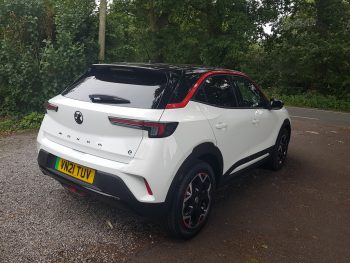
The Mokka-e has already been used to take a single mattress to the tip
Report 7:
Our Mokka-e reports have very much focused so far on life with an EV and charging etc, as well as the car’s sharp styling and ease of use.
But our tests of the car so far have also shown its practicality.
While I’ve said the boot is a little smaller than I would like with the seats upright, the Mokka-e has already been used to take a single mattress to the tip. Because there’s not a huge amount of fore and aft sliding movement on the front seat, and it only slightly inclines forwards, I couldn’t quite fit it lengthways but luckily the mattress was able to bend. The fact that the boot release is actually under the tailgate never fails to confuse me though.
I’ve also been impressed and increasingly reliant on the safety kit that’s available as standard.
The lane keeping aid is very exuberant and I had originally taken to switching it off as was tired of wrestling with it. But aside from one slip road off the M27 where it picks up on the spider’s web of old road markings and thinks I’m in the wrong place, I’ve become used to it now and just leave it to do its thing. I’d like to think it will come in handy someday but at the same time hope it won’t need to. Same with the driver drowsiness alert.
The blind spot warning is working well – as it’s a similar colour to the indicators, it threw me for the first few months, but I’ve now got used to it and finding it a great help.
And after some initial doubts over the optional (£700) IntelliLux Matrix LED headlights with advanced forward lighting, I’ve really seen the benefit of them. I certainly notice the difference when driving other, older cars and have to even check whether I’ve actually got the headlights on, as they’re so much dimmer. Not that I can spend much time analysing it, but it’s quite fascinating watching how the lights on the Mokka-e adapt to certain situations, such as switching to not dazzling an oncoming car while simultaneously lighting up trees to the side of the road and it’s certainly been a benefit during winter months.
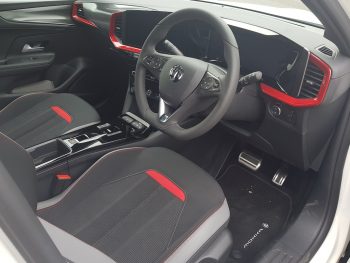
The interior on our long-term Mokka-e matches the exterior for striking looks
Report 6:
While life with a home charger has definitely made a difference to the convenience of an electric car, I don’t think I’d go as far to say it’s a total and utter game changer.
Certainly, even if I couldn’t have a home charger installed, I’d be pushing for an EV anyway. That’s based on my experiences of the savings in fuel costs – particularly pertinent at the moment – but also the driving experience and the desire to be part of the growing EV movement, reinforced by the latest research on climate change, such as the IPCC report.
And, as mentioned before, a fast-growing number of public chargers is really transforming the EV experience too. A recent meet-up with the Stag Publications ladies for afternoon tea reinforced this for me. As it was a 200+-mile round journey, I needed to incorporate charging en route but a check in advance showed there was an impressive choice of charge points actually directly on my journey, with no need to turn off.
And while I’d already stopped nearby to our destination to charge before arriving, the hotel actually had a charge point that hadn’t appeared when I searched online. Better still, it was available and free to use for the duration of the time I was there.
I’m also quite enjoying incorporating charging into journey planning; the speed of today’s charge points means that you don’t need to stop for long and the variety of facilities at charging locations means you’re actually spoilt for choice for things to do.
But definitely make sure you’re not reliant on a particular charging location being in operation and available when you arrive; a particular example being the recent storms where I’ve heard of drivers turning up to locations to find they weren’t working. Luckily, I’d already axed plans to see friends so didn’t have to deal with such an issue.
As well as continuing to enjoy the EV experience, I’m still finding life with the Mokka-e great. I continue to love the fact that its exterior looks mean it stands out on the road – as reflected by the fact that it won Top Gear’s ‘Design of the Year’ title at the Topgear.com Awards. But the interior also matches the exterior for striking looks. Although the black headlining is a little sombre, the cabin generally looks very good and the red detailing really lifts it. The dashboard is well laid out and I love the inclusion of physical controls for the climate control and infotainment volume, alongside the touchscreen and steering wheel-mounted controls.
I’m also highly appreciative of the elevated seating position and view, supporting visibility. While the chunky pillars do mean that rear visibility is a little constrained, there’s a wealth of ADAS kit to support safety – more in the next report.
Although my everyday driving tends to be around town, where the Mokka-e’s light steering and manoeuvrability come into their own, I’ve now carried out a lot of longer-mile journeys in our Vauxhall long termer and can really vouch for its comfort here, supported by comfortable ride and a lack of wind noise. Quiet and refined motoring that’s also zero emission. There’s a lot to be said for that.

Our long-term Mokka-e
Report 5:
The year of the EV has been some time coming but I have to say I am genuinely flabbergasted by the number of electric cars and charge points rapidly appearing everywhere.
I’m suddenly seeing lots of green-flash numberplates going past when I park the Mokka-e on our drive or out and about. Ditto with charge points. I drove to a retail park the other side of Southampton the other week and was really pleased to see four InstaVolt charging points, each with a 120kW and a 50kW connector. All were in full use too for the duration of my two-hour stay there so I was rather glad that I didn’t actually need them.
I’ve also been pleased to note that the new EV charger at the supermarket over the road not only has two 50kW connectors but is also situated further away from the store than some other supermarkets I’ve seen. This only makes it easier to access but also means drivers are far less likely to be ICE’d – I know there’s infrastructure issues at play but putting chargers right outside the store and then not policing them is just an incentive for lazy ICE drivers, and even store delivery drivers, to park there, as I’ve seen all too well.
All of which is less important than it used to be as we have a home charger at last!
Installed before the government grants on home chargers end in April, it’s certainly been a game-changer for me, although as noted above, the UK charging infrastructure has changed quite dramatically in the time we’ve been testing the Vauxhall. Zap-Map stats reveal there were 29,320 public charging devices across the UK at the start of this month compared to 25,521 devices at the start of September 2021 – a whopping 14.9% increase. So while I’m grateful for having a driveway that enables home charging – compared to the estimated 40% of drivers who don’t – I’m also mindful of the fact that it’s getting far easier to charge out and about. This has been demonstrated by a raft of announcements on new charging deployments and partnerships in recent weeks, although it’s clear much more work is needed.
The charge point engineer, who drives a Peugeot e-Partner, also made me feel guilty about my range anxiety anecdotes when he told me about his typical daily trips/mileage and how he’s embraced charging while out and about.
I have to say I’m loving the experience of driving an electric vehicle, including not feeling so guilty when the topic of climate change crops up in anything.
While I’ve very much become used to driving everywhere in Eco mode – so much so that I can tell the moment I pull away if I’ve forgotten to change from Normal mode or even accidentally put it in Sport – I’m still appreciative of the Mokka-e’s performance.
The Mokka-e might ‘only’ have 136hp but that 260Nm of torque is certainly noticeable, particularly in urban traffic.
Its effect on my wallet (well, purse), is also noticeable. At a very rough guess, I’d say I’m saving about £60 a month on charging compared to fuel costs. I know the outlook for energy costs is not good at the moment but neither is it for fuel, with a record-high in oil prices.
I really, really wish the Mokka-e had an interior light for the back seats though. It would save me a lot of muttering and resorting to the torch on my phone when I’m trying to find an abandoned lunch box or school tie on dark winter afternoons/evenings.
I have to say I’m loving the Mokka-e’s light signature. Plip the keys and the lights dance around before settling down to a menacing glare. I think I’m showing my age but it’s like a modern-day Knight Rider. A passer-by wasn’t so appreciative the other day and got a bit of a shock though when I nipped out for a hunt for some school artefact left in side. My kids love it though.
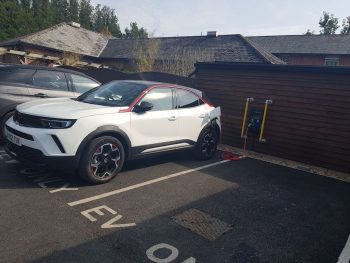
Some well-timed eco practices have stretched the Mokka-e’s range much further
Report 4:
The Christmas period and trips for shopping or out with the kids gave me a chance to put the Mokka-e’s official 201-mile range (now 209 for new models) to the test further.
I’m typically getting about 145 miles on mixed routes and in eco mode but with mainly conventional ICE car driving practices and speed.
However, a few journeys have shown that I could do much better than this.
In all cases, I was closer to the wire on range than I’d have normally liked – not helped by cold weather and some last-minute changes of plan.
In one case, it meant that I had to tackle a return journey with some 40 miles less range than I’d used on the way there and with no rapid charging facilities en route until I was close to home. Cue some careful sub-50mph driving and even more careful acceleration/braking.
Thankfully, I was able to complete 47 miles of journey on 17 miles of range in one case and 19 miles on 8 miles in another case. Always reassuring to know for the future.
I’ve also downloaded the Vauxhall My Connect app and activated the e-Remote charging but without a home charger I’ve not made much use of the functionality. However, we have one due imminently so I will be able to hit the ground running.
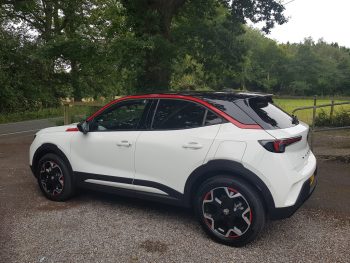
The Mokka-e won Top Gear’s ‘Design of the Year’ title at the Topgear.com Awards 2021
Report 3:
It’s been a busy few weeks for Vauxhall’s Mokka-e electric crossover in the news.
First up was the announcement that it had won Top Gear’s ‘Design of the Year’ title at the Topgear.com Awards 2021, on the back of its use of the brand’s new design language – due to be rolled out on more models – and assertive looks.
I actually gave a little whoop out loud when I saw the news as it’s been clear since the start of our long-term test that the Mokka-e is a headturning car, from the attention it gets out on the road and in car parks. I’ve found that it certainly stands out if you’ve forgotten where you’ve parked it…
More noteworthy for fleets was the news that Vauxhall has slashed the pricing on the Corsa-e and Mokka-e. The price drop comes as a result of the cuts to the Plug-in Car Grant, announced mid-December and bringing the grant down to a maximum of £1,500 from the previous £2,500 while the price ceiling drops from £35k to £32k.
Responding to this, Vauxhall has levied a £3,000 reduction across all Corsa-e and Mokka-e versions with immediate effect, equating to a £2k price cut when you factor the grant in. It means that for the Mokka-e, OTR prices including the grant now start from £29,365 and rise to £30,495. Our SRi now stands at £30,435; a reduction of 6.2%.
Vauxhall has also announced that it’s extended the driving range on both the Mokka-e and the smaller Corsa-e through a number of updates. As with similar improvements to siblings elsewhere in the Stellantis group stable, the models now have a more efficient heat pump, new transmission reducer – which converts motor revs to wheel speed to optimise range – and latest low rolling resistance tyres.
As a result, the Corsa-e range on the WLTP cycle increases 6% from 209 to 222 miles while the Mokka-e is up 4% from 201 to 209 miles. It doesn’t sound much but as Tesco says…
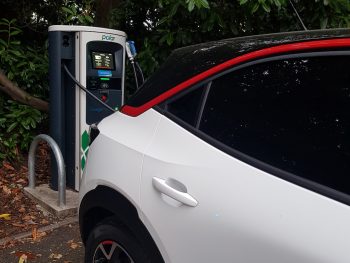
Local chargers at New Forest hotels have proved highly helpful during our test so far
Report 2:
Several weeks into our test of the Vauxhall’s electric small SUV and I feel like I’ve taken a quantum leap in my charging knowledge. That’s after a bit of a scare over how little infrastructure there is locally though.
Prior to taking delivery of the car, I downloaded Zap-Map – now the most essential app on my phone – to check out local charging as we don’t have a home charger. I knew there were a couple of devices at the local Asda but wasn’t sure of other locations. When the app first opened, it showed a wealth of chargers and I was ecstatic. Until I realised it was centred around Bristol where Zap-Map is based. And when I homed in on my address, there was a veritable ‘charging desert’ in the local town.
Luckily, I live near the New Forest where there are a number of hotels with charge points. So I have spent a fair few weeks frequenting them and partaking in coffees/cream teas or even sitting quietly in the grounds like Billy No-Mates on a Friday night with a wedding going on inside. There was also a rather manic afternoon with four of us turning up in a row to use the single rapid charger there and charging as much as politely allowed before passing the baton on. The couple after me were staying at another local hotel that didn’t have a charger and had had to drive over. I also had to return to the same place for a coffee one Friday evening after the charger at Beaulieu Motor Museum had been out of action that afternoon during the school holiday.
All of this has reinforced to me just how much of a role the leisure and hospitality sector has in the UK’s EV infrastructure and how much of a selling point it is for venues.
I’ve not had so much luck with the local Asda charging. The devices there are quite often out of action and only 7kW so I’m not adding that much to my range while in-store. And the second time I tried to charge, the bays were filled with three ICE cars and a diesel Asda delivery van – and I couldn’t find anyone from Asda to help. After getting stuck on the one-way system and having to park at the end of car park, I walked back and saw the driver of one of the cars returning with a full trolley. So I asked if she knew she’d parked in an EV charging bay and pointed out that I’d not been able to charge my car as a result. She then snapped at me that all the parent parking bays were full and she wasn’t going to park any further away. So many things to say back, but I gave up for fear of being punched, and decided best not to enquire where her actual kid/s were!
I have now regularly been ‘ICE’d’ in several places, hotels too, and after years of hearing friends and colleagues say about it, I am really starting to understand the frustration. Given my experiences, I can understand why venues might not want to anger customers by asking them to move their cars, but it does need tackling…
Since then, literally in the last couple of weeks, two Mer 22kW charge points have now been deployed in a car park fairly near me – both an indication of just how fast-paced changes to the infrastructure are and a saviour from me being socked one at Asda.
Car-wise, it’s been a great experience so far and I’ve really enjoyed getting to grips with the Mokka-e, which continues to gather attention and draw comments on its looks. I’m pleased ours comes with the red exterior detailing as it really does lift the car. The cabin looks good too, matching the exterior’s looks well. It’s also been great driving an electric car during the fuel delivery shortages and COP26; I’ve not just felt smug but also relieved and part of a bigger picture.
In terms of performance, the Vauxhall has 136hp on tap, giving a 0-60mph time of 8.7 seconds and a top speed of 93mph; it can certainly get a shove on it but it’s worth noting that its full power is only available in ‘Sport’ mode. Default ‘Normal’ restricts this to 109hp and the ‘Eco’ model that I always use cuts it down further to 82hp. In the latter, performance is definitely stunted but it’s still punchy at pulling anyway and capable on motorways, and besides range is my priority. I’m also activating the full regen braking around town, but not motorways, to optimise power. In general, I’m finding both the regen braking and power delivery less aggressive than other EVs I’ve driven, making the Mokka-e easy for ICE drivers to switch to.
Official range is 201 miles but I’m getting around 145 on mixed routes and in autumn weather. That’s with keeping the air-con and heaters off, bar a blast of the demisters at the start. But I am using the heated front seats a lot – I’ve never been so happy about heated front seats in my life. Under my calculations, I’m getting 3.2MPkWh. This could be better but I’ve never been great at hypermiling, even in ICE vehicles, when I’m normally racing around juggling work and school runs. So the priority for me is to practise smoother driving.
Cabin space is great – head room at the front is plentiful, though more limited for rear seat passengers. They do have plentiful leg room though and sliding rear seats would be a godsend to maximise boot space, which is 310 litres with the seats upright or 1,060 folded. This puts it on a par with some smaller cars and means I can’t carry my mum’s wheelchair unless I put the 40/60 split seats down on one side and shunt my kids up so they’re next to each other – normally not a recipe for a relaxed journey.
There’s acres of equipment onboard our SRi Nav Premium trim. I’ve very quickly warmed to the optional (£700) IntelliLux Matrix LED headlights with advanced forward lighting – previous intelligent headlights have left me a bit unconvinced and scrabbling around to switch the main beam off. These react far quicker than I ever could (they’re a bit sensitive in country lane situations though) and light up the side of roads well.
The panoramic rear-view camera also works sublimely well – including when it comes to accessing the main hotel charge point I use. The parking spaces there are extremely tight and the camera makes it so much easier to manoeuvre in. It’s also great for helping with reversing into our skew-whiff drive and adds in extra details (I honestly didn’t realise we had a manhole!).
Above all, I’ve realised that you can definitely make an electric vehicle work if you don’t have a home charger and if you have the appetite for it. Just be prepared for some charge points to be out of action, or to have to queue if they’re rapid, and have a back-up plan. And maybe don’t tackle drivers who’ve ICE’d you…
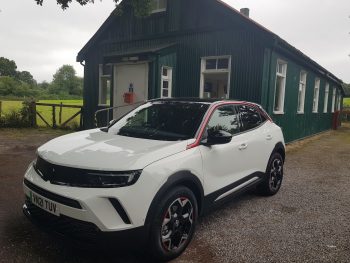
Our Mokka-e feels like the right car at the right time
Report 1:
We’ve gone electric for one of our latest new long-termer arrivals, with our new Vauxhall Mokka-e small SUV replacing our previous Suzuki Swace hybrid estate.
When you include our prior Vauxhall Combo Life long-termer last year, it means we’ve gone from diesel to hybrid to fully electric in some 12 months.
It’s a journey that many readers and their fleet drivers are starting to do too – and some are cutting out the hybrid middle man.
It’s a switch I’ve been very much keen to embrace. While I’ve tested electric cars short term, this is my first pure electric long-termer and comes at an ideal time, as the fleet sector ramps up the pace on EV adoption in the countdown to the 2030 ICE ban.
And it’s also been a rather opportune time as our Mokka-e arrived just before the fuel panic-buying chaos, leaving me able to join the smug EV driver club.
Launched autumn 2020 as part of the second-gen Mokka line-up, the Mokka-e marked the first all-electric variant of Vauxhall’s smallest SUV. The sister model to the 2008, the Mokka is built on the Stellantis Common Modular Platform (CMP), opening up all-electric options alongside petrol and diesel.
It features a single front-mounted electric motor producing 136hp and 260Nm of torque and with a sole 50kWh battery option that gives it a 201-mile official WLTP range (but more in Eco mode). It also has a 0-60mph of 8.7 seconds – and it can certainly get a shift on when required.
The Mokka-e also comes with a standard 11kW on-board charger and supports up to 100kW rapid DC charging, with a 0-80% charge taking 30 minutes.
Its rapid charging capability is something that I’ve already been making the most of as I don’t, for the moment, have a home charger.
So I’m reliant on the local infrastructure and I’ve been shocked how little of that there is. Luckily, there are a number of hotels nearby and I’ve become reliant on them. The battery is also guaranteed by an eight-year/100,000-mile warranty.
It’s been clear right from the start that the Mokka-e is a striking-looking car that turns heads – particularly in its White Jade paintwork and with the black/red detailing and its 18-inch black/silver alloy wheels. The kids and I were particularly delighted to see the same colour combo used for the Mokka-e on display at the Stellantis stand at Carfest this summer.
The interior looks good too – an expanse of curved dashboard with a 10-inch colour touchscreen, flat-bottomed leather-covered steering wheel, red stitching and alloy sports pedals.
Our sporty SRi Nav features acres of kit, including a Multimedia Navi Pro system with sat nav, front and rear parking distance sensors and a panoramic rear-view camera and 12-inch digital instrument panel.
In fact, there’s not many options offered across the whole range and those that are, are heavily focused on customisation, such as paintwork choices, a white roof and a black bonnet. The only add-ons fitted to ours are the White Jade paintwork (£420) and the £700 IntelliLux Matrix LED headlights with advanced forward lighting, which I’ve been very impressed with so far – more on those later.
All in all, it looks like the right car at the right time.
P11d (BiK): Was £34,880 now £31,880 excl. PiCG (2%) Range: 201 miles for our model Test Range / mpkWh: 145 / 3.2mpkWh












